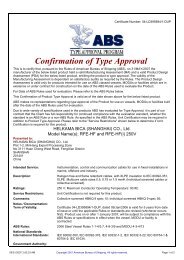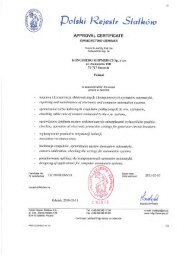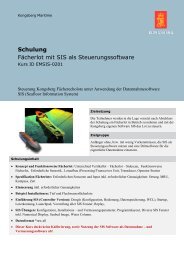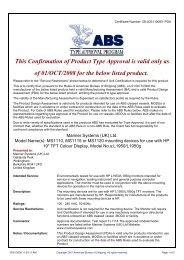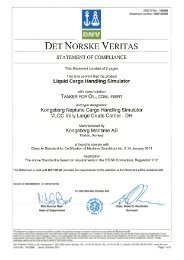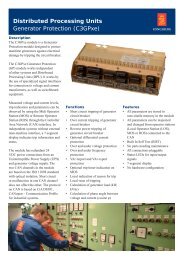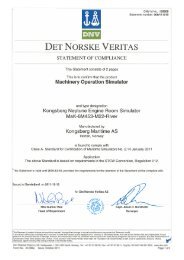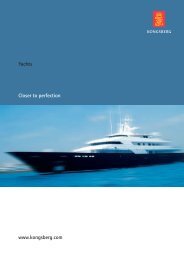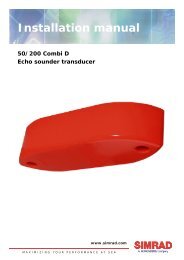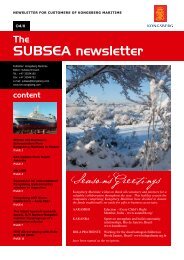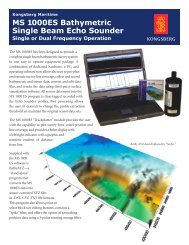Annual Report 2011 - Kongsberg Maritime - Kongsberg Gruppen
Annual Report 2011 - Kongsberg Maritime - Kongsberg Gruppen
Annual Report 2011 - Kongsberg Maritime - Kongsberg Gruppen
You also want an ePaper? Increase the reach of your titles
YUMPU automatically turns print PDFs into web optimized ePapers that Google loves.
of materials, direct payroll expenses and a portion of directly attributable<br />
overhead costs. Capitalised development costs are recognised on the<br />
balance sheet at acquisition cost less accumulated amortisation and<br />
impairment loss. Amortisation is based on expected useful life, based on<br />
the total production units or number of years. The remaining expected<br />
useful life and expected residual value are reviewed annually.<br />
The estimation of financial benefits is based on the same principles<br />
and methods as for the impairment testing. This is based on long-term<br />
budgets approved by the Board. For more details about estimation, see<br />
Note 11 “Intangible assets”.<br />
Assessments of the fulfillment of the criteria for capitalising development<br />
costs take place on an ongoing basis throughout the completion<br />
of the development projects. Based on technical success and market<br />
assessments, a decision is made during the development phase whether<br />
to complete development and start capitalisation.<br />
Maintenance<br />
Maintenance is the work that must be performed on products or<br />
systems to ensure their expected useful life. If a significant improvement<br />
is made on the product or system that leads, for example, to a prolongation<br />
of the life cycle, or if the customer is willing to pay more for the<br />
improvement, this is to be considered as development. Expenses related<br />
to maintenance are expensed as incurred.<br />
Technology and other intangible assets<br />
Technology and other intangible assets acquired and which have determin<br />
ed useful life are measured at cost less accumulated amortisation,<br />
as well as accumulated impairment losses. Amortisation is determined on<br />
expected useful life based on total production units or number of years.<br />
The expected useful life and the stipulated amortisation rate are<br />
reviewed during each period.<br />
G) Property, plant and equipment<br />
Property, plant and equipment are recognised at cost, net of accumulated<br />
depreciation and/or any accumulated impairment losses. Such cost<br />
includes expenses that are directly attributable to the acquisition of the<br />
assets. Property, plant and equipment are depreciated on a straight-line<br />
basis over their expected useful life. When individual parts of a property,<br />
a plant or equipment have different useful lives, and the cost is significant<br />
in relation to total cost, these are depreciated separately. Expected<br />
residual value is taken into account when stipulating the depreciation<br />
schedule.<br />
The remaining expected useful life and expected residual value are<br />
reviewed annually. Gains or losses upon disposal of property, plant and<br />
equipment are stipulated as the difference between the sales price and<br />
the carrying amount of the unit, and recognised net as other income in<br />
profit and loss. Expenses incurred after the asset is in use, e.g.<br />
day - to -day maintenance, are expensed as they are incurred. Other<br />
expenses which are expected to result in future economic benefits and<br />
can be measured reliably, are capitalised.<br />
H) Leases, sale and leaseback<br />
Leases or sales with leaseback where KONGSBERG generally takes over<br />
all risk and all benefits related to ownership, are classified as financial<br />
leases. On initial recognition, the asset is measured at the lower of fair<br />
value and net present value of the agreed minimum rent. After initial<br />
recognition, the same accounting policies are used as for the corresponding<br />
asset.<br />
Other leases are operational leasing agreements and are not recognised<br />
on the Group’s balance sheet. KONGSBERG’s sale and leaseback<br />
agreements are considered to satisfy the criteria for operational leasing<br />
agreements. Where a sale and leaseback agreement is defined as a<br />
onerous contract according to IAS 37, the present value is added into the<br />
expected loss.<br />
I) Impairment of non-financial assets<br />
All non-financial assets are reviewed for each reporting period to<br />
de termine whether there are indications of impairment. Where indications<br />
of impairment exist, recoverable amounts are calculated.<br />
The recoverable amount of an asset or cash-generating unit is the<br />
highest of its value in use or fair value less net cost to sell. Value in use is<br />
calculated as the net present value of future cash flows. The calculation<br />
of net present value is based on a discount rate before tax and reflects<br />
current market assessments of the time value of money and the risks<br />
specific to the asset.<br />
Impairment is recognised if the carrying amount of an asset or<br />
cash- generating unit exceeds its recoverable amount. A cash-generating<br />
unit is the smallest identifiable group that generates a cash inflow that is<br />
largely independent of other assets or groups. Impairment related to<br />
cash-generating units is intended first to reduce the carrying amount of<br />
any goodwill allocated to the unit and then to reduce the carrying<br />
amount of the other assets in the unit on a pro rata basis. These assets<br />
will normally be property, plant and equipment, and other intangible<br />
assets. Where the individual asset does not generate independent cash<br />
inflows, the asset is grouped with other assets that generate independent<br />
cash inflows.<br />
Non-financial assets which have been subject to impairment losses<br />
are reviewed during each period to determine whether there are indications<br />
that the impairment loss has been reduced or no longer exists.<br />
Reversal of previous impairment is limited to the carrying value the asset<br />
would have had after depreciation and amortisation, if no impairment loss<br />
had been recognised.<br />
J) Financial instruments<br />
Financial assets and liabilities<br />
Financial assets and liabilities consist of derivatives, investments in<br />
shares, accounts receivable and other receivables, cash and cash<br />
equivalents, loans, accounts payable and other liabilities. A financial<br />
instrument is recognised when the Group becomes party to the instrument’s<br />
contractual provisions. Upon initial recognition, financial assets<br />
and liabilities are assessed at fair value plus directly attributable expenses.<br />
The exception is financial instruments, where changes in fair value are<br />
recognised through profit and loss, and directly attributable costs are<br />
expensed. An ordinary purchase or sale of financial assets is recognised<br />
and derecognised from the time an agreement is signed. Financial assets<br />
are derecognised when the Group’s contractual rights to receive cash<br />
flows from the assets expire, or when the Group transfers the asset to<br />
another party and does not retain control, or transfers practically all risks<br />
and rewards associated with the asset. Financial liabilities are derecognised<br />
when the Group’s contractual obligation has been satisfied,<br />
discharged or cancelled.<br />
Classification<br />
The Group classifies assets and liabilities upon initial recognition based on<br />
the intended purpose of the instrument. The Group classifies financial<br />
assets in the following categories:<br />
i) Fair value through profit and loss<br />
ii) Loans and receivables<br />
iii) Available-for-sale financial assets<br />
Financial derivatives are included in the category ‘fair value through profit<br />
and loss’, also if the derivative has a negative value.<br />
Receivables and liabilities related to operations are measured at their<br />
amortised cost, which in practice implies their nominal value and provision<br />
for expected losses.<br />
Except for investments in subsidiaries, joint ventures or associates in<br />
the statement of financial position on the date of the balance sheet, all<br />
shares are defined as financial instruments available for sale. Availablefor-sale<br />
financial assets are measured at fair value on the date of<br />
report ing. Changes in the value of available-for-sale financial assets are<br />
recognised in the statement of comprehensive income (OCI), except for<br />
impairments, which are recognised through profit/ (loss). See Note 4<br />
“Fair value” for a more detailed description of how fair value is measured<br />
for financial assets and liabilities.<br />
The company’s financial liabilities are recognised at amortised cost,<br />
except for financial derivatives, which are recognised at fair value<br />
through profit and loss.<br />
Impairments on financial assets<br />
When there is objective evidence that a financial asset’s value is lower<br />
than its cost, the asset will be written down through profit/(loss).<br />
Impairment in the value of assets measured at amortised cost is<br />
calculated as the difference between the carrying amount and the net<br />
present value of the estimated future cash flow discounted by the<br />
2 INTRODUCTION<br />
7 DIRECTORS’ REPORT AND<br />
18 FINANCIAL STATEMENTS<br />
64 CORPORATE GOVERNANCE<br />
76 FINANCIAL CALENDAR AND ADDRESSES<br />
KONGSBERG <strong>Annual</strong> <strong>Report</strong> <strong>2011</strong> 25




